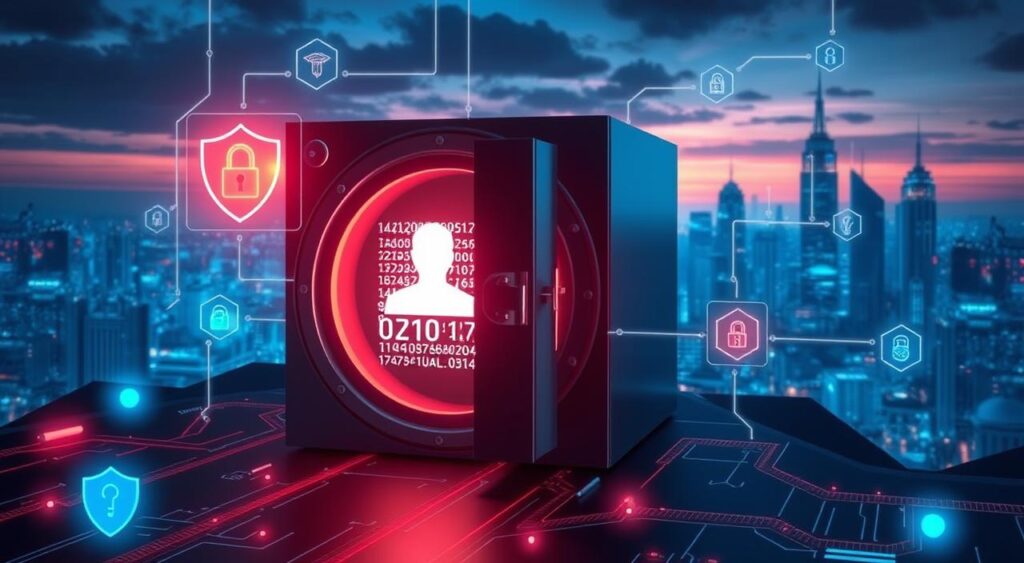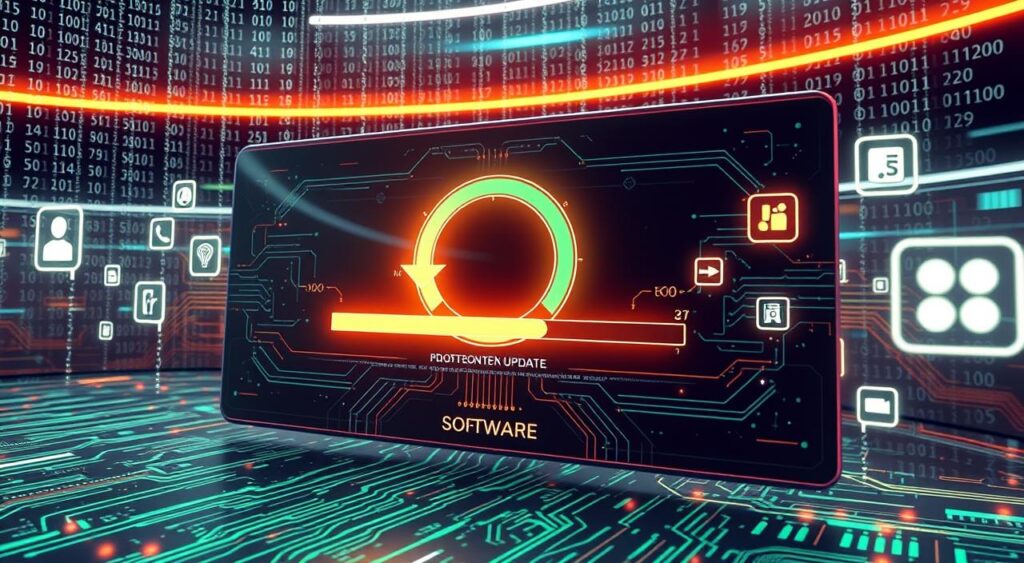
In today’s digital world, keeping personal data safe is key. Cyber threats are always changing, so we must stay ahead. How do we protect our sensitive info? Let’s explore the top cybersecurity tips to safeguard your digital life.
Key Takeaways
- Understand the common types of cyber attacks and identify potential security risks
- Create strong and unique passwords using password management tools
- Implement multi-factor authentication to enhance account security
- Secure your home network and devices to prevent unauthorized access
- Stay vigilant against phishing attempts and protect your email communications
Understanding Modern Cybersecurity Threats
In our digital world, cybersecurity threats keep changing. Cybercriminals are always looking for ways to exploit weaknesses. The cost of cybercrime is expected to hit $10.5 trillion by 2025.
Malware, viruses, phishing scams, and ransomware are just a few threats. They all pose risks to our personal data and online safety. These threats are becoming more complex every day.
Common Types of Cyber Attacks
Cybercriminals use many tactics to get past our defenses. Here are some common ones:
- Malware: This is harmful software that can steal our data or hold it for ransom.
- Phishing: It’s when scammers try to trick us into giving out personal info through fake emails or websites.
- Social Engineering: This tactic uses our behavior to get unauthorized access to systems or data.
- Ransomware: It’s malware that locks our files and demands money to unlock them. The costs are in the trillions.
Identifying Potential Security Risks
To keep our digital lives safe, we need to be proactive. We should update our software, use strong passwords, and protect public interfaces. Cybersecurity experts say that most data breaches come from just ten vulnerabilities.
Impact of Data Breaches
Data breaches can cause a lot of harm. They can lead to identity theft, financial loss, and the loss of personal info. The cost of these breaches is in the trillions globally.
Most breaches come from outside threats. But, insider threats, both intentional and accidental, also play a big role. This shows we need strong security measures.
As our digital world changes, understanding cybersecurity threats is more important than ever. By being careful and using strong security, we can protect ourselves and our families from cyber attacks and data breaches.
Creating Strong Password Strategies
In today’s digital world, keeping our personal data safe is key. Experts say we should use passwords that are at least 16 characters long. These should mix upper and lower-case letters, numbers, and symbols, or be a memorable phrase of 4 to 7 words.
It’s important to have unique, strong passwords for each account to keep our info safe from hackers. While it might seem hard, password managers can help. They let us generate, store, and fill in these secure passwords easily. We only need to remember one strong password for the manager itself.
- Use passwords that are at least 16 characters long, with a mix of upper and lower-case letters, numbers, and symbols.
- Consider using a memorable passphrase of 4 to 7 unrelated words instead of a single, random password.
- Employ a password manager to securely store and generate unique, strong passwords for each of your accounts.
- Avoid using weak passwords or repeating the same password across multiple accounts, as this significantly increases the risk of being hacked.
By using these password management tips, we can make our email, social media, and financial accounts much safer. This helps protect our personal data from cyber threats.
“The vast majority of individuals find it challenging to remember long, random, and unique passwords for each account without the assistance of a password manager.”
Implementing Multi-Factor Authentication
Keeping our online accounts safe is key in today’s world. Using multi-factor authentication (MFA) is a great way to do this. MFA asks for more than one thing to get into an account, like a password and a fingerprint.
Types of Authentication Methods
MFA can send a special code to your phone or email. You can also use apps like Duo Mobile or Bitwarden’s TOTP generator. These codes change often and help fight off hackers.
Benefits of MFA Implementation
Turning on MFA makes your account much safer. Even if someone guesses your password, they still need the extra code. Microsoft says MFA stops 99.9% of attacks.
It also helps meet security rules and saves money. Data breaches can cost millions, but MFA can prevent most of these problems.
Setting Up MFA on Different Platforms
Many online services let you use MFA. For example, the University of Kentucky suggests Duo app for its accounts. Using MFA with single sign-on (SSO) makes logging in easier and safer.
It’s important to teach everyone about MFA’s value. Keeping MFA policies current helps fight new cyber threats.
“Utilizing push notifications via the Duo app for MFA can offer more cybersecurity protections than SMS texts or emails.”
Cybersecurity Tips for Protecting Personal Data
In today’s digital world, keeping our personal data safe is more important than ever. Cybercriminals are always finding new ways to get into our online lives. So, we must take steps to protect our sensitive information from threats like data breaches and identity theft.
Managing our digital footprint is a key step. We should be careful about what personal info we share on social media. We should also set our privacy settings right and use tools like encrypted messaging and ad blockers. These actions help lower the risk of our data being misused.
Knowing our rights under laws like GDPR and CCPA helps us control our online data better. We should watch our accounts for anything odd and report identity theft quickly. This helps lessen the harm from such incidents.
The FBI says they got 3.26 million internet crime complaints from 2018 to 2022. This shows how urgent it is to focus on data privacy and identity theft prevention. By being proactive with our cybersecurity, we can protect ourselves and our families from digital threats.
“Cyber threats are evolving fast, and we must stay alert to protect our personal info. Simple yet effective steps can help keep our digital lives safe.”
As cybersecurity changes, staying informed and using strong protection is key to keeping our data safe. By working together, we can confidently and securely explore the digital world.
| Key Cybersecurity Statistics | Data |
|---|---|
| Ransomware attacks per day | 4,000 |
| People reusing passwords | 59% |
| Breaches due to human error | 87% |
| Financially motivated data breaches | 71% |
| Users checking for secure websites | 46% |
| Increase in cyber insurance policies | 25% |
Securing Your Home Network Infrastructure
In today’s world, keeping our home networks safe is more important than ever. As we spend more time online, protecting our devices and data is key. By setting up strong security, we can keep our information safe and our online activities private.
Router Security Settings
Our router is the heart of a secure home network. We must change the default login and update the firmware often. Also, using the latest encryption, like WPA3 or WPA2 with AES, helps protect our wireless connections.
Network Encryption Protocols
Choosing the right encryption protocol is vital for network security. We suggest using WPA3 Personal for its strong encryption and security features. If WPA3 isn’t available, WPA2 with AES is a good alternative to keep our data safe.
Guest Network Configuration
Creating a separate guest network for visitors and IoT devices is wise. It keeps our main network safe from threats. With a unique password for the guest network, we can safely share our internet with others.
By taking these steps, we can greatly lower the risk of cyber attacks. Regular updates, strong encryption, and a guest network are essential. These measures help protect our digital lives from harm.
Software Updates and Patch Management
It’s vital to keep your software and systems updated with the latest security patches. Cybercriminals often target outdated software for vulnerabilities. So, it’s wise to enable automatic updates whenever you can. Also, getting rid of unsupported devices and software can help reduce security risks.
The Cybersecurity and Infrastructure Security Agency (CISA) says updates fix security holes and bugs. Attackers might wait months or years to exploit these vulnerabilities. CISA suggests setting updates to automatic to keep your systems safe without manual effort.
Always download updates from the official vendor’s website to avoid malware or phishing. Automatic updates can install updates right away, so you don’t have to check manually. Checking your update settings regularly, like every quarter, helps keep your devices and apps secure.
| Statistic | Value |
|---|---|
| Percentage of data breaches due to unpatched vulnerabilities | 60% |
| Average time to patch critical vulnerabilities | 38 days |
| Percentage of successful cyber attacks that could have been prevented by timely updates | 80% |
| Percentage of organizations experiencing malware infections due to not updating software promptly | 70% |
| Percentage of cyber attacks targeting vulnerabilities in outdated software | 43% |
Keeping your software current is the best way to defend against attackers. Regularly updating your software and managing patches can greatly lower your risk of security threats. This helps protect your personal data.

Safe Internet Browsing Practices
As we explore the digital world, keeping our data safe is crucial. Simple steps can boost our online security and reduce risks. This way, we can enjoy the internet more safely.
HTTPS and SSL Verification
First, check if a website starts with “HTTPS”. This means it’s encrypted, protecting your data. Also, check the SSL certificate to ensure the site is trustworthy.
VPN Usage Guidelines
Using a Virtual Private Network (VPN) is a smart move for secure browsing and online safety. A VPN encrypts your internet connection, hiding your activity. Choose a reliable VPN and follow their advice for best security.
Browser Security Settings
Setting up your browser’s security can make a big difference. Turn on pop-up blockers, download prevention, and site warnings. Also, use privacy tools and ad-blockers to protect your data.
By following these tips, we can surf the web more safely. We can protect our personal info from cyber dangers.
Data Backup and Recovery Solutions
Protecting our personal data is key in today’s digital world. Using strong data backup and recovery plans is a top way to keep our info safe. Regular backups can protect us from cyber attacks, hardware failures, and natural disasters.
We have many options for data backup. Cloud-based solutions give us lots of storage and let us access our files anywhere. Local backups on hard drives or removable media add extra security. It’s vital to check our backups often to make sure they work.
If a breach or attack happens, a good incident response plan helps a lot. It outlines how to handle the situation, who does what, and how to communicate. This plan is crucial for keeping the damage small and getting back to normal quickly.
| Backup Type | Advantages | Disadvantages |
|---|---|---|
| Cloud-based Backups |
|
|
| Local Backups |
|
|
By having a solid data backup and recovery planning strategy, we can greatly lower the chance of losing our data forever. This ensures our personal info stays safe against new cyber threats.

Social Media Privacy Protection
In today’s world, social media is a big part of our lives. But, these platforms can also put our privacy at risk. It’s important to protect our personal data and online identity as we use social media.
Configuring Robust Privacy Settings
First, check and adjust your privacy settings on social media. Learn about options like who can see your posts and your profile info. This way, you control who sees your personal data.
Mindful Information Sharing
Be careful about what you share online. Don’t share too much personal info like your address or phone number. Share things that are safe and fit your goals, keeping your privacy in mind.
Managing Your Digital Footprint
Your online presence can affect you a lot. Clean up your social media by removing old posts and photos. This helps keep your personal info safe from misuse.
| Social Media Privacy Best Practices |
|---|
|
By following these tips for social media security and online privacy, you can protect your digital life. Keep your data safe, guard your identity, and enjoy social media without risking your security.
Mobile Device Security Measures
In today’s world, our smartphones and tablets are key parts of our lives. They hold lots of personal and work info. So, keeping our mobile devices safe is very important. By taking a few simple steps, we can protect our mobile security and smartphone protection better.
First, we need to use strong passcodes or biometric methods like fingerprints or facial scans. These steps help keep our info safe from hackers. Also, it’s key to keep our devices and apps updated. Updates fix security holes and make our devices safer.
When downloading apps, be careful and only get them from trusted stores. Stay away from apps that seem shady, as they might harm your device. It’s also smart to have features that let you track and wipe your device remotely. This helps keep your data safe if your device gets lost or stolen.
Public Wi-Fi networks are another big risk. Try not to do important stuff on these networks, as hackers might listen in. To stay safe, use a VPN when you’re on public Wi-Fi. This encrypts your data and adds extra security.
By following these steps, we can keep our personal info safe and our devices secure. In today’s digital world, being proactive about security is crucial. It helps protect our data and keeps our privacy safe.
| Mobile Security Measure | Description |
|---|---|
| Strong Passcodes/Biometrics | Use strong passcodes or biometric methods like fingerprints or facial scans to secure device access. |
| Software Updates | Keep operating systems and apps up-to-date to address vulnerabilities and enhance overall security. |
| App Vetting | Download apps only from official and reputable sources to minimize the risk of malware infections. |
| Remote Tracking and Wiping | Enable features that allow you to locate, lock, or erase data from a lost or stolen device. |
| Public Wi-Fi Precautions | Avoid sensitive activities on public Wi-Fi networks and use a VPN for added protection. |
Email Security and Phishing Prevention
In today’s digital world, keeping our email safe is key to protecting our personal info and stopping identity theft. Phishing is a big threat where scammers pretend to be real people or companies to get our sensitive info. They do this through fake emails.
Identifying Phishing Attempts
To stay safe from phishing scams, we need to carefully check every email. Even if it looks like it’s from someone we know, we should be cautious. Watch out for urgent messages, strange attachments, or requests for personal info.
Phishing emails usually have spelling mistakes, don’t use our names, and have wrong email addresses. These are signs they might be scams.
Email Encryption Methods
Using email encryption can make our messages safer. Encryption methods like S/MIME or PGP protect our emails from hackers. This way, even if someone tries to intercept our emails, they won’t be able to read them.
Safe Attachment Handling
Phishing scams often come with harmful attachments that can harm our devices. We should be careful with any attachments we get from unknown senders. It’s best to check if the sender is real and if the attachment is safe before opening it.




